Modeling a Bandwidth of a Two-Level Independent Quantum Laser System States
Modeling a Bandwidth of a Two-Level Independent Quantum Laser System States
Author(s): Cliff Orori MosioriSubject(s): Energy and Environmental Studies
Published by: Altezoro, s. r. o. & Dialog
Keywords: Einstein coefficient; spontaneous emission; spectral line profile function; small-signal gain coefficient; population inversion; laser cavity;
Summary/Abstract: An electromagnetic radiation is basically considered to be a transverse wave propagating through an accessible media whether it is an optical fibre or a thin film depending on its propagating conditions. In analyzing its propagation, utilized specific cross-section areas have become an important base of understanding its extinction parameters. The term cross-section in this work applies only to boundary conditions within which particles interact within electromagnetic spectra through absorption or scattering. In such small volume contextual framework, nanotechnology reconsiders scattering cross-section coefficients. In this work, two different degenerate states were modeled and analyzed using a developed model of a laser cavity containing a media of length, L, with a gain of, k, per unit length which were mirrored to represent the upper and a lower level manifolds inhomogeneous broadening Stark levels respectively. The model developed created an impression that a laser medium is a coherent ensemble of particles or atoms whose bandwidth depends on how a laser is constructed.
Journal: Traektoriâ Nauki
- Issue Year: 3/2017
- Issue No: 12
- Page Range: 2012-2018
- Page Count: 7
- Language: English

